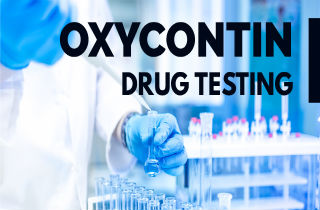Yes. OxyContin shows up on drug tests. In fact, a simple 5 panel drug screen can easily detect oxycodone.
OxyContin is a narcotic painkilling medication which contains oxycodone, an opiate routinely screened for in drug tests. Because of the high rate of abuse associated with OxyContin (oxycodone gets you high), standard drug screens will be able to detect OxyContin in urine. More on OxyContin detection here and a section for your questions about OxyContin drug tests at the end.
Why order a drug test for OxyContin?
Employers and law enforcement officials are increasingly cracking down on any drugs which are abused. Because of its high addictive potential, OxyContin is one such drug. So, authorities routinely test for OxyContin as a matter of course.
In other cases, OxyContin drug tests are a medical necessity. For example, if you’re admitted to a hospital with a suspected drug overdose and can die from OxyContin, toxicology screening may be done. Doctors need to know exactly what drugs you’ve been taking before they can appropriately diagnose and treat you. Furthermore, drug testing may be ordered during psychiatric treatment as a part of diagnosis or during opiate treatment to make sure that you are dosing as prescribed. Finally, because oxycodone can react strongly with other central nervous system depressants, OxyContin drug tests may be routinely ordered when you are diagnosed with other medical conditions.
Types of OxyContin testing
The most common method that doctors who prescribe OxyContin use is drug testing patients via urine screen. However, OxyContin may also be detected using blood or hair samples, but these tests are less frequently used. A blood sample is only helpful immediately after taking a drug. Hair samples might be used to detect past OxyContin use several weeks after taking the drug – this is mostly used to make sure someone with prior OxyContin abuse is sticking to their drug treatment program.
OxyContin detection windows
A typical testing and confirmation cutoff concentration for most opiates and opiate derivatives is 300 ng/ml (nanograms per milliliter). The typical detection time of OxyContin in urine samples is 1-3 days. This is because oxycodone hits peak levels in urine within eight hours. Levels start to drop after 1-2 days. Because of such a short detection window, low levels of OxyContin may not be picked up by urine tests, in which case hair testing may be used instead.
OxyContin use and abuse
OxyContin abuse is dangerous. The pain killer is highly addictive and can cause painful withdrawal effects, as well as drug-seeking behavior even in people who originally take OxyContin as prescribed. Taking OxyContin in high amounts of over extended periods will lead to a tolerance for the drug, which causes abusers to take larger amounts for the same effect. This greatly increases the risk of an overdose, which can cause breathing problems and high blood pressure, or even coma and death. Risk of serious adverse side effects increase when you chew, snort, inhale or inject OxyContin or take it other than prescribed.
OxyContin show up on drug test questions
OxyContin is currently one of three most addictive prescription drugs subject to serious abuse. If you or someone you know are taking this without legitimate reason, OxyContin will be detected in most job, law enforcement and treatment center urine screens. If you have additional questions about OxyContin testing, please let us know. We try to respond to all legitimate queries with a personal and prompt response.









Related Posts